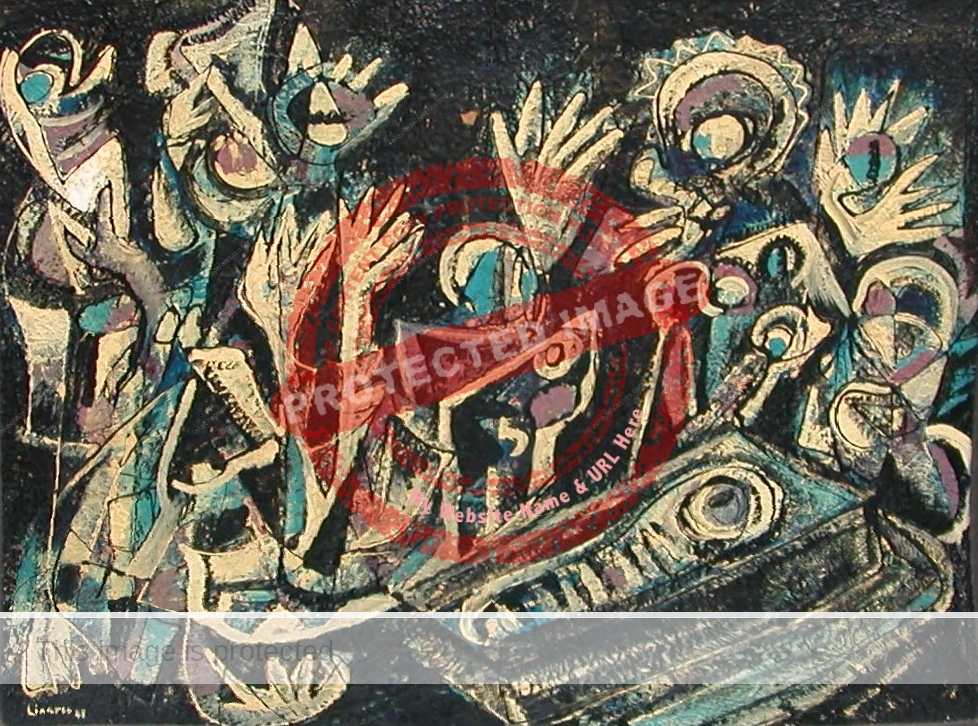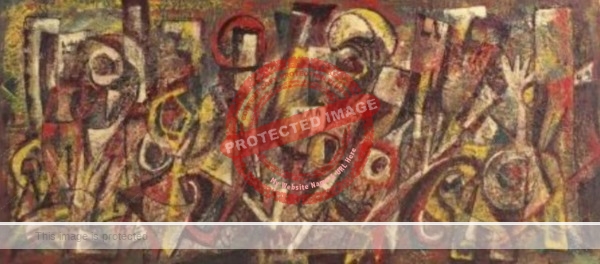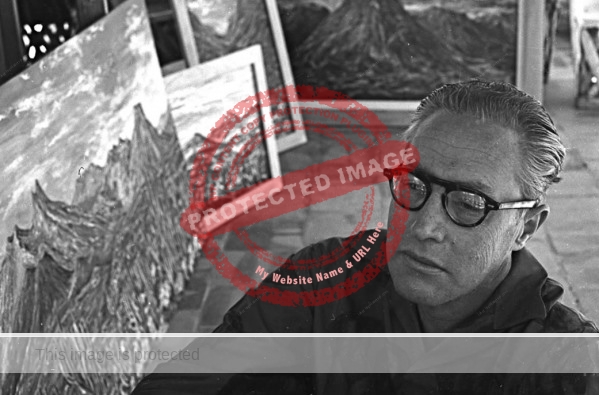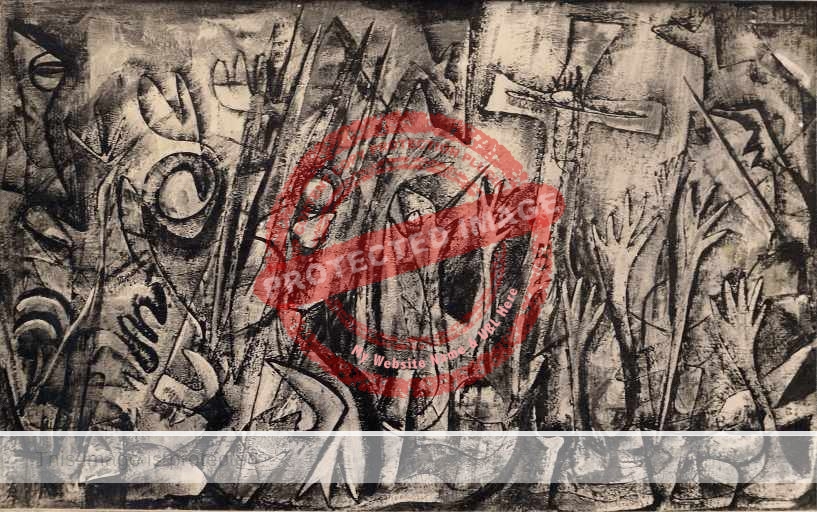Innovative Mexican artist Ernesto Butterlin, aka Linares, sometimes Ernesto Linares, or more simply “Lin,” had close ties with Ajijic and was active in the 1940s and 1950s. Ernesto’s parents and his two older brothers were all born in Germany and moved to Mexico in 1907, sailing first class aboard the “Fürst Bismarck” of the Hamburg-America line, from Hamburg to Veracruz. The family settled in Guadalajara, but also owned a huerta (orchard) near Ajijic. Ernesto was born in Guadalajara on 4 September 1917.
The 1930 Mexican census, conducted on 15 May of that year lists the members of the household as:
- Juan Butterlin 59, engineer, born in Germany
- Amalia de Butterlin 49, born in Germany, speaks German, English, French
- Ernesto Butterlin 12
- Ma de Los Angeles Delgadillo 40, maid
- Ma Guillermina Flores 16
- Ma del Refugio Flores 12
By the early 1940s, Ernesto, then in his twenties and using the name Linares for his art, was living and painting year-round in Ajijic. From about 1943 to 1945, he shared his village home with American artists Charmin Schlossman Lanier and Sylvia Fein, whose husbands were on active military service overseas. American writer Neill James first moved to Ajijic in September 1943 and in an early article about the village described Linares as a “young Mexican abstract painter who is currently showing his works in a traveling exhibition in the USA.” That brief description shows that Ernesto had already achieved some success as an artist, even at this early age.
A more detailed description of Ernesto and his work comes from the notebooks kept by Victor Serge, a Russian living in exile in Mexico, who visited Ajijic in December 1944 and stayed over the New Year:
“Ernesto Butterlin reminds me of Pilnyak. Often with lacquer for car bodies, he earnestly makes surrealist or abstract pictures in jumbled lines and lively tones, sometimes decorative. He wants to make money in New York, be someone, and this method worries him, and he genuinely loves art, and he’s full of inhibitions and poses. Big, blond, pince-nez, the untroubled face of a good German.”
In about 1945, Ernesto entertained visiting American artist George Buehr (1905-1983), a professor at the Art Institute of Chicago, as his house guest.
In January 1947, Ernesto exhibited in a group show at Villa Montecarlo in Chapala, alongside fellow artists Charmin Schlossman, Muriel Lytton-Bernard and Dick Kitchin. Charlotte Wax also appears to have had paintings in that show.
Shortly afterwards, in about 1947, American artist, anthropologist and author Tobias Schneebaum arrived on the scene. Schneebaum lived and painted in Mexico, including several spells in Ajijic, from 1947 to 1950. In Ajijic, he quickly became friends with Ernesto. In Wild Man, Schneebaum writes, “A young blond painter, born in Guadalajara of German parents, also lived in Ajijic. He was twenty-seven, blue-eyed, four inches over six feet, and very handsome, and was subject to the attentions of both the men and the women who later passed through town…”
“His family owned property in Ajijic, fields of corn and beans through which he moved like a country squire. Ajijic was small, with a population of three thousand, barely a third of whom had homes in the village itself, the other two-thirds living on their farms. He knew everyone by name and was adored and respected by old and young alike. He’d changed his Germanic name to Linares to identify more closely with the country of his birth, and liked to be called Lynn. He painted during the day with bright reds and yellows in wide bands of color, freely brushed and ripped on, a technique he claimed preceded Jackson Pollock, who he insisted had seen his work. He’d had one-man shows in New York and Mexico City.” (Wild Man, 12).
Elsewhere, Schneebaum describes how Ernesto “had inherited a considerable amount of farmland on the outskirts of Ajijic, but he spent most of his time painting in a drip technique that might have preceded the work of Jackson Pollock.” (Secret Places, 7)
Schneebaum, Ernesto Butterlin and a third artist Nicolas Muzenic were all employed by Irma Jonas to teach students attending her summer painting schools in Ajijic (held 1947-1949 inclusive). According to Schneebaum, an ill-fated love triangle developed between the three artists at this time, complicated by the arrival of “haughty and radiantly beautiful” Zoe, the “fourth member of our group”, who had previously been living with Henry Miller in Big Sur, when she heard about Lin and decided to visit Ajijic:
“After my return to Ajijic from Mexico City, other foreigners came to stay, notably Nikolas (sic) Muzenic, with whom I fell in love. He had been a student of Josef Albers at Black Mountain College… Nikolas, alas, fell in love with Lynn, not with me. It was a disastrous affair that started out as if it would last forever. Nikolas remained in Ajijic for about two years…” (Secret Places, 7)].
In Wild Man, Schneebaum recalls that, “Lynn’s casual ways bewitched and irritated Nicolas, just as Nicolas’s arrogant, snobbish manner attracted and mortified Lynn. Nicolas moved into Lynn’s house and began a frenzied, volcanic affair that lasted two years.” (Wild Man, 13) Schneebaum adds that Nicolas eventually bought the property and forced Butterlin to move out, complete with his large collection of pre-Columbian art.
In about 1948, Ernesto Butterlin, in association with one or more of his brothers, opened an art gallery in Ajijic. This is the gallery pictured in the Life Magazine article (23 December 1957) about Ajijic. The “Margo de Butterlin” or “Margaret North de Butterlin” described in that article was Otto’s lover (during his marriage to Peggy); Margo married Ernesto (who was gay) in order to acquire the Butterlin surname; she appears to have provided the financial means to help establish the gallery. In Life Magazine, she is described as “both rich and fashionable”, as well as, “US-born but Mexican by her last marriage”. The article goes on to say that “Her present husband runs the Galeria where the painters display their works and also buy drinks.”
Disappointingly little is known of what became of most of Ernesto Butterlin’s pioneering artworks, and whether any are held in public collections, though both Ernesto and his older brother Otto were among the 28 artists given a joint exhibition in June 1954, in Mexico City, at the Instituto Nacional de Bellas Artes’ Salón de la Plástica Mexicana. Other artists whose work was featured on that occasion include Roberto F. Balbuena, Michael Baxte, Leonora Carrinqton, Enrique Climent, José Feher, Elvira Gascón, Gunther Gerzso and Carlos Mérida.
In 1962, ‘Linares’ exhibited at the 1st Annual Exhibition of Paintings and Sculptures on Ajijic Beach, organized by Laura Bateman’s Rincón del Arte gallery. Other artists from Ajijic in this juried show with prizes, held in front of Posada Ajijic, included Antonio Cárdenas, Mary Cardwell, Juan Gutiérrez, Dick Keltner, Carlos López Ruíz, Betty Mans, Gail Michels, John Minor, Eugenio Olmedo, Florentino Padilla, Tink Strother, Digur Weber, Doug Weber, Rhoda Williamson, Sid Williamson, Javier Zaragoza and Paul Zars. Also exhibiting were José Ramos and Padre Santiago Ramírez (both from Jocotepec) and Javier Martínez (from Chapala), as well as Alfredo Santos and Gustavo Sendis from Guadalajara.
Ernesto Butterlin died in 1964. Schneebaum’s claim that Lin “…committed suicide. In order to fit his six-foot, four-inch body into the coffin, it was necessary to cut off his feet at the ankles.” (Secret Places, 7) is sensationalist and less than reliable. Ernesto Butterlin’s funeral and wake were held at the home in Ajijic of John Lee, an American writer who was a friend of the artist in the early 1960s. Lee has written that Ernesto, who “stayed single and was a friend of Eric, the Hildreths, the Hoppers, and me”, “died of cancer”, a version of events substantiated by others who were around at the time, including the art gallery owner Katie Goodridge Ingram.
Partial list of sources:
- Colony Reporter (Guadalajara), 16 July 1964.
- El Informador: 24 Jan 1947, 6; 2 June 1962, 11.
- Tobias Schneebaum, Wild Man, Viking Press, 1979
- Tobias Schneebaum, Secret Places: My life in New York and New Guinea, University of Wisconsin, 2000
This article was updated on 1 May 2016 to include mention of Ernesto Butterlin’s wife. As always, we would love to receive any comments, corrections or additional information.
Related posts:
- Unraveling the story of Lake Chapala’s artistic Butterlin brothers
- Frederick W. Butterlin (ca 1905-?), photographer
- German-Mexican artist Hanns Otto Butterlin (1900-ca 1960)
Tony Burton’s books include “Lake Chapala: A Postcard History” (2022), “Foreign Footprints in Ajijic” (2022), “If Walls Could Talk: Chapala’s historic buildings and their former occupants” (2020), (available in translation as “Si Las Paredes Hablaran”), “Mexican Kaleidoscope” (2016), and “Lake Chapala Through the Ages” (2008).




I have to paintings signed Limares and the years 1929 and 1958 writing below name. They are of country sceneries. Who is this Linares?
There are several artists who signed their work “Linares”. Assuming the subject matter is “realistic countryside”, the two you have are highly unlikely to be by Ernesto Butterlin who was known for his abstracts. The earlier painting is clearly not going to be by him since he would have been only 12 years of age at the time. Sorry not to be of more help, TB.
If interested in selling please contact me , I’m his nephew and don’t have anything of him. As a family value I would like to have something
Thank you
Mónica Señoret
Good afternoon Monique
My family are in possession of 3 signed original Butterlin artworks. We also lived in the Chapala and other surrounding areas
Chula Vista and Ajijic. Would love to connect with you.